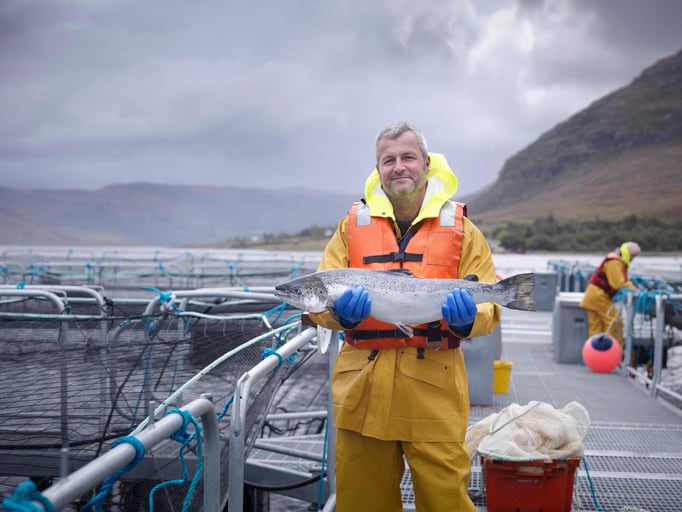Researchers from the University of Stirling’s Institute of Aquaculture found by-products – such as fish heads, frames, trimmings, skin and organs – are an underutilised resource that could support the sustainable growth of Europe’s aquaculture sector and increase food supply.
As part of the Green Aquaculture Intensification in Europe (GAIN) project, Stirling PhD researcher Wesley Malcorps found that a large proportion of commonly farmed species – Atlantic salmon, European seabass, gilthead seabream, common carp and turbot – were being routinely wasted in industrial and household processing.
While the most strategic application requires an economic analysis to determine market acceptability, he claimed fish by-products could be capitalised on by food manufacturers.
For example, 10% of the Norwegian salmon by-products (heads and frames) are considered a high value export product to Asian countries where they are used in soups. Another pathway could be the utilisation in processed foods, such as fish sausages, sauces, and cakes.
“Although fish by-products don’t sound appetising, they are full of goodness and can be used for many purposes – including in food supply and diet supplements. Our results show a substantially higher total flesh yield (64-77%) can be achieved if fish are fully processed, compared to fillet only (30-56%), as is often the case,” revealed Malcorps.
“Heads, frames and trimmings from all species show potential to increase the food supply, in soups or processed foods, such as fish fingers, sauces and fishcakes. They could also be processed into food extracts and nutraceuticals – such as protein powders, fish oil and collagen supplements – potentially producing a higher economic value.
“Organs can be used in animal feed, as can skin, due to its high protein, low ash content. With their high level of valuable omega-3 fatty acids, feeding by-products to livestock would also contribute to nutrition in the human food chain, and by-products can also be used in pet food too.”
Taste and texture implications?
Does using food waste in well-know food products impact taste and texture? "It depends on what you consider ‘waste’," Malcorps told FoodNavigator. "As heads are considered waste in Europe, but are being used in soups in Asia to add flavour. Also think about crisps made from fish skin, which taste excellent, available in shops and online stores. It’s all about extracting as much flesh from the fish as possible (beyond just the fillet) and maintaining food grade, so most by-products can be used for human consumption. By-products can form a product of their own as fish fingers, or fishcakes, or mixed if legislation and consumer preferences allow it. "
Fish waste 'full of goodness'
Fish by-products contain Omega-3 (n-3) long-chain polyunsaturated fatty acids (LC-PUFA), eicosapentaenoic acid (EPA), and docosahexaenoic acid (DHA), the research noted. These are key micronutrients for human and animal health. Additionally, seafood consumption can improve intake of other key micronutrients such as vitamin D and B12, iodine, selenium, and other minerals as well as being a good source of bioavailable protein.
A global shortage and increase in value of these nutrients therefore creates incentives to use by-products more efficiently: an estimated one third of all EPA/DHA originating from wild and farmed fish globally is discarded.
Malcorps claimed the current 33% of by-products that is used in fish feed – such as fishmeal, fish oil and protein hydrolysate – could be increased, which could greatly reduce the environmental impact of aquaculture.
“European aquaculture is dependent on imported feed from marine and terrestrial systems, such as fish meal, oil and soy, particularly for carnivorous species such as salmon,” he explained. “Substituting plant for marine ingredients just shifts the impact from sea to land, and also risks compromising the health and welfare of the cultured animal.”
The substitution of marine ingredients with plant ingredients in aquafeeds, he explained, risks both compromising the health and welfare of the farmed animal and can also affect micro- and macro nutrient levels in the final consumed product. Therefore, it is important to take a larger food system approach into account, as unintended consequences of shifts in feed type used may occur along the entire value chain. A re-evaluation of the potential to increase the supply of marine ingredients from under-utilised by-product resources has received far less attention, according to the researcher.
Packaging solutions
Finally, the study showed potential industrial uses of by-products in food packaging. Examples include the manufacture of films and coatings based on fish gelatin and chitosan (a sugar that is obtained from the hard outer skeleton of shellfish.
“Fish skin offers potential for extracting collagen and gelatine, as an alternative source to cattle or pigs,” Malcorps added.
The study was overseen by Professor Dave Little, also of the Institute of Aquaculture, who said: “Using the whole fish is a key component of the sustainable intensification of seafood. There are issues to address in terms of technology and infrastructure, which would need capital investment to resolve, but our analysis indicates that by-product separation could add value and nutritional efficiency.
“It could increase aquaculture’s output without using more resources.”
Reference
'Nutritional characterisation of European aquaculture processing by-products to facilitate strategic utilisation'
Frontiers in Sustainable Food Systems
https://doi.org/10.3389/fsufs.2021.720595





